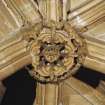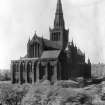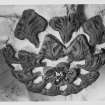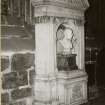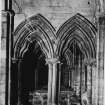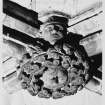Following the launch of trove.scot in February 2025 we are now planning the retiral of some of our webservices. Canmore will be switched off on 24th June 2025. Information about the closure can be found on the HES website: Retiral of HES web services | Historic Environment Scotland
Glasgow, Glasgow Cathedral, 70 Cathedral Square, Cathedral Of St Mungo
Cathedral (12th Century), Human Remains (20th Century), War Memorial(S) (20th Century)
Site Name Glasgow, Glasgow Cathedral, 70 Cathedral Square, Cathedral Of St Mungo
Classification Cathedral (12th Century), Human Remains (20th Century), War Memorial(S) (20th Century)
Alternative Name(s) Barony Kirk; Glasgow Cathedral; High Church; Metropolitan Kirk; St Mungo's; War Memorials & Rolls Of Honour
Canmore ID 45002
Site Number NS66NW 17
NGR NS 60248 65577
Datum OSGB36 - NGR
Permalink http://canmore.org.uk/site/45002
First 100 images shown. See the Collections panel (below) for a link to all digital images.
- Council Glasgow, City Of
- Parish Glasgow (City Of Glasgow)
- Former Region Strathclyde
- Former District City Of Glasgow
- Former County Lanarkshire
NS66NW 17.01 60255 65657 Burial Ground (New Burial Ground)
(NS 6025 6557) Cath (NAT)
OS 6" map (1967)
Glasgow Cathedral (which is still in use) stands on the site of a monastery founded by St Kentigern in the 6th - 7th century. It was rebuilt, probably as a small cruciform church, and consecrated in 1136. Numerous extensions and rebuildings took place until the 15th century, when it assumed its present form.
C A R Radford 1970
A watching brief was carried out during excavation of a floodlighting track around the cathedral. Two sets of reburied skeletal fragments were found between the treasury and the sacristy. A small feature consisting of three stones mortared together and set on a clay soil was found on the N side of the building, opposite the stair tower of the N door. Most of the trench passed through disturbed levels, except at the E end of the cathedral, where it revealed the natural orange clay subsoil below topsoil.
Some slabs were lifted within the W doorway, and revealed a layer of rubble above some larger blocks. Part of the foundations of the butresses to the N and S of the door was also revealed. That on the S appears to be original, the N was rebuilt in the last century.
Sponsor: Friends of Glasgow Cathedral.
A Bailey 1992.
During the autumn and winter of 1992-3, extensive archaeological excavations were conducted in advance of the installation of a new heating and electrical system for the cathedral. Trenches were located where new ducts were to be installed below the floor in the Nave, the Choir, the Crypt and the Session Room. These trenches produced evidence for the construction of both the 12th-century cathedrals which preceded the present building. The early cathedrals were represented by in situ masonry and decorated fragments of masonry which had been reused in the 13th-century works. Traces of activity pre-dating the 13th-century were discovered in the W end of the Nave and important evidence was also recovered for the internal divisions of the post-Reformation use of the Nave.
Burials and stray human bones were found in the trenches dug in the Lower Church and the Nave. In total 77 burials were excavated, most of which can be reasonably well dated as well as hundreds of losse bones, which may be of any age. In the Lower Church no features relating to the site of St Mungo's tomb were found and most of the burials date to the early 19th century. In the Nave, burials were found which pre-date the 12th century structures and continued at irregular intervals to the 19th century.
Apart from the architectural fragments and coffin fittings, finds were scarce. The most significant artefactual discovery consisted of two massive medieval bronze martars and an iron pestle which had been deposited in a pit in the Lower Church.
Sponsor: Historic Scotland
S T Driscoll 1993
A small-scale excavation was carried out by GUARD in the NW corner of the Session Room in Glasgow Cathedral in October of 1993 in advance of the installation of a new electrical control board, consisting of three small trenches. The main trench was effectively an extension of the one which was opened in the 1992/93 season of work in Glasgow Cathedral (supra), and ran the length of the Session Room. Human remains were uncovered comprising five interments, four of which were excavated, which appeared to be contemporary with most of those recovered during the previous excavation i.e. early 19th century. Two additional trenches were dug in the kitchen area and the corridor which runs from the rear Session Room door to the door leading to the exterior of the Cathedral on the N. No features were visible in these trenches or the main trench other than the burials.
Sponsor: Historic Scotland
M [J] Richmond 1994
NS 602 655 A number of trenches were excavated to the N and E of the cathedral for the installation of CCTV cables and phone lines. Due to the sensitivity of the area a watching brief was undertaken and the following information was recorded.
Trench 1 was within the graveyard towards the NE corner. The soil was mixed and contained a number of fragments of disarticulated human bone. Two sandstone plot dividers were also found.
Trench 2 was outwith the graveyard and ran parallel to the E wall. A number of disarticulated human bones were unearthed. An articulated human skeleton (aligned W-E), an infant's skull and a fragmented adult skull were all recovered. Iron fittings were also located, possibly the remains of coffin fittings.
Sponsor: Glasgow City Council.
L H Johnstone 1997
Scheduled as Glasgow Cathedral, precinct and graveyard.
Information from Historic Scotland, scheduling document dated 20 November 2002.
NS 602 655 A watching brief was undertaken in May 2004 during the excavation of four test pits within the western graveyard, in an area previously disturbed during earlier phases of work along the northern elevation (DES 1993, 82).
The purpose of the test pits was to track the main gas pipe from the cathedral to the junction box on the boundary wall. Although this area had already been greatly disturbed, it was thought likely that human remains would be uncovered. Although not clearly identifiable as human, bone fragments were frequently encountered.
Archive to be deposited in the NMRS.
Sponsor: HS.
C Shaw 2004
NS 6020 6556; NS 6024 6555 Two small trenches were excavated at Glasgow Cathedral in February 2005 in advance of
works to install lift machinery, the first situated at the eastern end of the S transept and the second at the western end of the nave, at the base of the main entrance. Both trenches reached a maximum depth of 0.4m.
The trench in the S transept revealed human remains, the distribution of which suggested they had been redeposited in an unceremonial manner. The origin of these remains is unknown, but it is thought likely they would originally have been buried within the cathedral grounds. In the trench at the main entrance, two possible graves with in situ human remains were partially revealed.
Archive to be deposited in NMRS.
Sponsor: HS.
S Hogg and C Shaw 2005
NS 602 655 Four periods of work required monitoring and recording at Glasgow Cathedral between February and September 2006. As part of a staged survey of the external elevations, the E elevation was drawn, photographed and recorded. The work was intended to complete existing survey data and to identify significant archaeological features. To this end, all relevant alterations and repairs to the monument, both historical and recent, as well as records of original architectural details, were completed.
Flooring slabs were removed in three separate areas on the northern and southern side of the lower church. The slabs were lifted to assess the thickness of the slabs and the underlying ground conditions and also to allow cables to be laid to provide power to the lights on the handrails. At the base of each of three sets of stairs, secure fixing points were required to bed the handrails and where possible small foundation pads were to be excavated to accommodate these.
The first trench was on the northern side of the lower church at the foot of the steps from leading from the treasury. This area was of particular interest as most of the area concerned had not been disturbed. In this trench a possible grave marker with an E-W alignment was seen. The slabs in the other two trenches (at the NE corner of the lower church at the base of the stairs near the chapter house, and at the SE corner of the lower church) clearly had been lifted and re-set during the excavation and installation of the heating system in the 1990s.
We recorded a gargoyle and its setting after its removal from the SE corner of the cathedral. The gargoyle was carved from blond sandstone, now so heavily weathered that its form was unrecognisable.
Finally, paving slabs and cobbles outside the W and S doors were removed. A subsequent, shallow excavation in the area beneath the cobbles near the S door was monitored. Nothing of archaeological significance was noted and no finds were retained.
Archive to be deposited in NMRS.
Sponsor: Historic Scotland.
Angus Mackintosh and Claire Shaw, 2006.
NS66NW 17.01 60255 65657 Burial Ground (New Burial Ground)
Crypt - 1250, Choir - 1250, Nave - 1300, Chapter House - 1420, Fergus Aisle - 1500.
David Hamilton 1812 - opened West window and repaired tracery
Edward Blore - restoration of crypts 1835 (executed by Nixon)
James G Graham, A W N Pugin, Robert Matheson, 1850, C H Wilson - stained glass
William Stark - choir of Inner High Church
NMRS REFERENCE:
Plans:
I G Lindsay Collection W/293
Plans by J Collie, 1836
Proposed restoration
Drawings by Glasgow Royal Technical College done for the National Art Survey
Inglis Photograph Collection Acc No 1994/90
'Glasgow Cathedral from the Necropolis. 474. AI.'
Scomberg Scott Plans
New chair and desk in the Sanctuary as a memorial to the RAF Glasgow Squadron and new table in St Nicholas Chapel
Acc No 1993/69
Three pages from a dismembered photograph album including one page containing four views of the cathedral - one exterior and three interiors
Ross Sketchbook MS 28/463/14/1 (unlocated at time of upgrade 3.9.1999)
Chapter House details
EXTERNAL REFERENCE:
Mitchell Library
T Fairburn's Relics of Anc Arch p1 - view from Garnethill
p5 - tombs in churchyard
Bygone Glasgow - text illustrations of door of crypt
Glasgow in Former Times 1 - pencil and wash sketch of tower before removal
2 - engraving
- lithograph c.1837
William Graham 1 p18 - photograph of head of St Thomas
- tower showing Bishop Lauder's Arms
p20 - five photographs including Blackadder's
2 p4 - photograph of George Rogus memorial in burial ground
- photograph 1876
- engraving 1849
- engraving of crypt
- pencil and wash sketch of West tower
Glasgow and Lanarkshire Illustrated p8 - article and photograph
Courtauld Institute: Sculpture Neg:
Sir John Steel Monument to William Graham B77/4192
R Jackson Monument to Robert B Anderson B77/4193; 888/72(3)
J Mossman Monument to Major W Middleton B77/4165; 888/72(6); (5); 889/1(7); (8)
P MacGillivray Monument to James Hedderwick B77/4194; 889/1(9)
Sir John Steell Monument to 93rd Sutherland Highlanders 877/4164; 888/72(2); (1)
Scottish Record Office
Painted window in Glasgow Cathedral
Payment of £24.5.5 (pounds) to C Heath Wilson [1809 - 1882]
Cash book
1864 GD 220/6/43
Records of Crown Estate Commissioners
CR4/143, 144
Reports on the state of the building in 1829 - 1838
RIBA Drawings Collection
J D Crace Sketch Book p36 - Sketch of interior, detail at Cross, details Blackadder crypt
Glasgow Architectural Association Sketch Book 1887, Vol 2 - Porch at South entrance to Crypt, Lady Chapel, North Transept, Chapter House
The Builder's Journal
May 27th and June 3rd 1896
Elevation and details of Chapter House doorway measured and drawn by Charles J Menart
The Builder's Reporter and Engineering Times
December 6th 1893
Drawing by John Honeyman of reredos
The British Architect
December 6th 1895
Two drawings of rood screen drawn by A Hemstock Hodge
Photographic Survey (1953)
Photographic survey by the National Buildings Record, Scottish Council, in 1953.
Publication Account (1985)
There has probably been an ecclesiastical establishment on the present site since Early Christian times. St Kentigem (popularly known as St Mungo) is reputed to have founded a church here in the late 6th or early 7th century, and later it served as the seat of the bishops of the Kingdom of Strathclyde. Glasgow retained its status following the absorption of the Kingdom of Strathclyde into that of Scotland, and the church underwent much alteration until the present layout was established in the 13th century. Little or nothing survives of these earlier churches, although it is likely that many fragments have been incorporated into the present fabric is it stands today, the building is of a somewhat unusual design comprising a double church, with the lower church lying below the choir of the cathedral. The lower church was designed to hold the relics of St Kentigern, but no longer does so, as they were removed in the later middle ages. The upper church is rectangular with the nave divided from the choir by a stone pulpitum placed between transepts which do not project beyond the walls of the nave. The eastern part of the church was rebuilt under the direction of Bishop Bondington (1233-58), but on stylistic grounds it is clear that the nave was not completed until the next century as it incorporates work of 14th century character. By the end of the 14th century the cathedral had assumed its present form; the only major addition was the erection of the Blacader Aisle on the south side of the church. This was began by Bishop Blacader (1483-1508), and was probably intended to house the Shrine of St Kentigern. Unfortunately it was never completed, only the lower portion being built. The west end of the medieval church was flanked by two towers, but these were removed in 1846. Preserved in the Lower Church there are a number of medieval monuments, a collection of architectural fragments (many of which come from the 12th century church), as well as the remains of the 13th century Shrine of St Kentigern.
Close by the cathedral there is the Necropolis containing an impressive array of tombstones dating from the 18th and 19th centuries.
Information from ‘Exploring Scotland’s Heritage: The Clyde Estuary and Central Region’, (1985).
Excavation (1992 - 1993)
During the autumn and winter of 1992-3, extensive archaeological excavations were conducted in advance of the installation of a new heating and electrical system for the cathedral. Trenches were located where new ducts were to be installed below the floor in the Nave, the Choir, the Crypt and the Session Room. These trenches produced evidence for the construction of both the 12th-century cathedrals which preceded the present building. The early cathedrals were represented by in situ masonry and decorated fragments of masonry which had been reused in the 13th-century works. Traces of activity pre-dating the 13th-century were discovered in the W end of the Nave and important evidence was also recovered for the internal divisions of the post-Reformation use of the Nave.
Burials and stray human bones were found in the trenches dug in the Lower Church and the Nave. In total 77 burials were excavated, most of which can be reasonably well dated as well as hundreds of losse bones, which may be of any age. In the Lower Church no features relating to the site of St Mungo's tomb were found and most of the burials date to the early 19th century. In the Nave, burials were found which pre-date the 12th century structures and continued at irregular intervals to the 19th century.
Apart from the architectural fragments and coffin fittings, finds were scarce. The most significant artefactual discovery consisted of two massive medieval bronze martars and an iron pestle which had been deposited in a pit in the Lower Church.
Sponsor: Historic Scotland
S T Driscoll 1993
Watching Brief (20 August 1996 - 26 August 1996)
NS 6025 6557 The excavation of service tracks for temporary office accommodation to the N of the cathedral was monitored by Kirkdale Archaeology. No finds were recovered from the site.
Sponsor: Historic Scotland
G Ewart 1996
Kirkdale Archaeology
Watching Brief (29 November 1997)
Kelburne construction ltd. had been contracted to widen the stretch of road just to the N of the cathedral, enlarging an existing car park outside the N entrance of the cathedral. This would involve excavating a triangular trench c. 11.5 m long, by a maximum of 1.05 m wide (although most of it was much less than this) to a depth of c. 40 cm.
After removal of topsoil it became apparent that the area was heavily disturbed, both by a cut for the already existing road, and by an electricity trench running down the side of this road. A single sherd of green glazed pottery, and much bone, including some human bone, was recovered from this electricity trench.
Although the evidence is minimal, it may be that the middle of the nineteenth century saw some raising of the ground level, with the 4 slabs noted in the trench (one dated 1811)buried c. 15 cm under modern ground level, while slabs dating to the 1870's are at the present ground level. As well as modern disturbance, a series of 4 grave slabs was found under the present turf line. One of these slabs (dated to 1811) was removed.
Sponsor: Historic Scotland
G Ewart 1997
Kirkdale Archaeology
Watching Brief (9 October 1997)
NS 6025 6557 A watching brief was maintained in October 1997 during digging of new foundations for kerbing and other works. The material removed was modern in character, and no finds were revealed.
Sponsor: Historic Scotland
D Murray 1998.
Excavation (8 February 2005 - 14 February 2005)
NS 6020 6556; NS 6024 6555 Two small trenches were excavated at Glasgow Cathedral in February 2005 in advance of works to install lift machinery, the first situated at the eastern end of the S transept and the second at the western end of the nave, at the base of the main entrance. Both trenches reached a maximum depth of 0.4m.
The trench in the S transept revealed human remains, the distribution of which suggested they had been redeposited in an unceremonial manner. The origin of these remains is unknown, but it is thought likely they would originally have been buried within the cathedral grounds. In the trench at the main entrance, two possible graves with in situ human remains were partially revealed.
S Hogg and C Shaw 2005
Sponsor: Historic Scotland
Kirkdale Archaeology
Standing Building Recording (December 2006 - January 2007)
NS 6024 6557 As part of ongoing maintenance work to the fabric of Glasgow Cathedral a standing building survey of the Chapter House took place in December 2006 and January 2007. The recent repairs to this part of the Cathedral were identified and recorded, as were historic repairs from the 19th century. The Chapter House was originally constructed during the mid-13th century but was partially demolished and rebuilt in the early 15th century. Evidence for the rebuild can be traced in the external stonework and this was recorded during the survey. Also noted were the early 17th-century gables and the 19th-century rebuild of the parapet. A significant amount of religious graffiti of unknown date has been carved into the buttresses and bays of the Chapter House. This was recorded and drawn to scale during the survey.
Archive to be deposited with RCAHMS.
Funder: Historic Scotland.
OASIS ID: kirkdale1-249638
Excavation (February 2006 - September 2006)
NS 602 655 Four periods of work required monitoring and recording at Glasgow Cathedral between February and September 2006. As part of a staged survey of the external elevations, the E elevation was drawn, photographed and recorded. The work was intended to complete existing survey data and to identify significant archaeological features. To this end, all relevant alterations and repairs to the monument, both historical and recent, as well as records of original architectural details, were completed.
Flooring slabs were removed in three separate areas on the northern and southern side of the lower church. The slabs were lifted to assess the thickness of the slabs and the underlying ground conditions and also to allow cables to be laid to provide power to the lights on the handrails. At the base of each of three sets of stairs, secure fixing points were required to bed the handrails and where possible small foundation pads were to be excavated to accommodate these.
The first trench was on the northern side of the lower church at the foot of the steps from leading from the treasury. This area was of particular interest as most of the area concerned had not been disturbed. In this trench a possible grave marker with an E-W alignment was seen. The slabs in the other two trenches (at the NE corner of the lower church at the base of the stairs near the chapter house, and at the SE corner of the lower church) clearly had been lifted and re-set during the excavation and installation of the heating system in the 1990s.
We recorded a gargoyle and its setting after its removal from the SE corner of the cathedral. The gargoyle was carved from blond sandstone, now so heavily weathered that its form was unrecognisable.
Finally, paving slabs and cobbles outside the W and S doors were removed. A subsequent, shallow excavation in the area beneath the cobbles near the S door was monitored. Nothing of archaeological significance was noted and no finds were retained.
Archive to be deposited in NMRS.
Sponsor: Historic Scotland.
A Mackintosh and C Shaw 2006
Standing Building Recording (12 February 2008 - 13 February 2008)
NS 6024 6557 As part of an ongoing project to record the exterior fabric of Glasgow Cathedral, a standing building survey of the Sacristy/Treasury, the N and S doors to the Lower Church, and the West Façade of the Cathedral, and measured drawing of carvings on the Blackadder Aisle, took place between March and May 2008.
The Sacristy/Treasury on the N side of Glasgow Cathedral originally dates to the mid-13th century. However, the
structure was almost completely demolished in the mid-19th century and rebuilt to approximately half its original height. Detailed recording of the building has identified residual parts of the mid-13th-century structure which survive in the base courses of the buttresses on the N and W sides.
The West Façade of the Cathedral was also substantially re-built in the mid-19th century following the demolition of two towers at the N and S ends of the façade. Surviving parts of the 13th-century base course were identified within the mid-19th-century rebuild.
In addition to this systematic survey the stonework of the S and N doors of the Lower Church and the carvings on the exterior of the Blackadder Aisle were recorded.
Archive: RCAHMS (intended)
Funder: Historic Scotland
Paul Fox and Tom Whalley (Kirkdale Archaeology), 2008
OASIS Id: kirkdale1-60206
Watching Brief (13 February 2008)
NS 6020 6557 A watching brief was maintained just to the N of the NW corner of Glasgow Cathedral during the
excavation of three small trenches on 13 February 2008. The trenches were required for the insertion of three new folding bollards. Below c0.3m of road surfacing, deposits were seen which were thought to be possible graveyard infill.
Archive: RCAHMS (intended)
Funder: Historic Scotland
Sarah Hogg (Kirkdale Archaeology), 2008
Standing Building Recording (16 November 2009 - 4 December 2009)
As part of ongoing consolidation work Kirkdale Archaeology performed a brief Standing Building Recording in Glasgow Cathedral in November and December 2009.
P Fox 2009
Sponsor: Historic Scotland
Kirkdale Archaeology
Watching Brief (10 August 2010 - 13 August 2010)
NS 6027 6560 A watching brief was maintained 10–13 August 2010 during the excavation of a trench to locate a blockage in a waste pipe serving toilets in the Treasury/Sacristy. Two discrete burials (one previously disturbed) and other human remains were identified in the heavily disturbed ground. There was evidence to suggest that when these burials were interred a path that runs E–W round the N side of the Cathedral was in its present position and that landscaping, possibly carried out during the establishment of the new burial ground had altered parts of the old burial ground.
Archive: RCAHMS (intended)
Funder: Historic Scotland
Paul Fox – Kirkdale Archaeology
OASIS ID: kirkdale1-279381
Watching Brief (18 January 2010 - 2 April 2010)
NS 602 656 A watching brief was carried out intermittently, 25 January–1 April 2010, during Historic Scotland’s ongoing consolidation work on elements of the W and S elevations. The consolidation and recording work focused on the eroded gargoyle sequence at clerestory level, the windows and the modification of the demolished SW tower.
J Godbert and P Fox 2010
Sponsor: Historic Scotland
Kirkdale Archaeology
Field Visit (29 July 2011)
NS 6022 6557 An inspection was made on 29 July 2011 of an area of flood damage on the N side of the nave of St Mungo’s Cathedral. Heavy rain had dislodged a significant amount of material around two of the exterior window bays. The material consisted of a mixture of small sub-rounded quartz pebbles (used as a decorative surface spread) and a mixed backfill containing modern glass, iron nails, scaffolding bolts and a single disarticulated human bone.
Archive: RCAHMS (intended)
Funder: Historic Scotland
Kirkdale Archaeology, 2011
Information also reported in Oasis (kirkdale1-123720) 20 November 2012
Ground Penetrating Radar (22 June 2018 - 23 June 2018)
NS 60248 65577 A geophysical survey over a small area adjacent to Glasgow Cathedral was undertaken, 22 – 23 June 2018. The work aimed to determine the location, nature and extent of potential surviving remains associated with earlier layouts of the Cathedral, in particular the earlier S transept.
Ground penetrating radar (GPR) surveys were undertaken over a 40 x 15m area. Given that it was thought that walls or wall cuts may survive beneath the later graves, surveys with both 500MHz and 250MHz antenna were undertaken.
As might be expected the data collected is dominated by responses from the burials and recumbent grave markers which exist throughout the survey area. The surveys have not detected any definitive anomalies which correspond with the postulated location of the earlier S transept. However, ephemeral anomalies have been detected which, given their location and orientation, may be archaeologically significant. However, interpretation is tentative given the extensive ground disturbance in the area due to remodelling of the cathedral and subsequent burials.
A zone of very strong responses has been recorded to the SE of the cathedral. These start to appear at c1.5m below the surface and extend for some depth. It is assumed that these are probably associated with landscaping of the area as the site expanded, although an archaeological origin cannot be entirely dismissed.
Archive: Rose Geophysical Consultants
Funder: CFA Archaeology on behalf of HES
Susan Ovenden – Rose Geophysical Consultants
(Source: DES Vol 19)
Photographic Survey
Photographs by the National Buildings Record, Scottish Council in 1952.
Dictionary of Scottish Architects (People)
Dictionary of Scottish Architects (People)
Dictionary of Scottish Architects (People)
Dictionary of Scottish Architects (Building)
Dictionary of Scottish Architects (Building)
Dictionary of Scottish Architects (Building)













































































































































